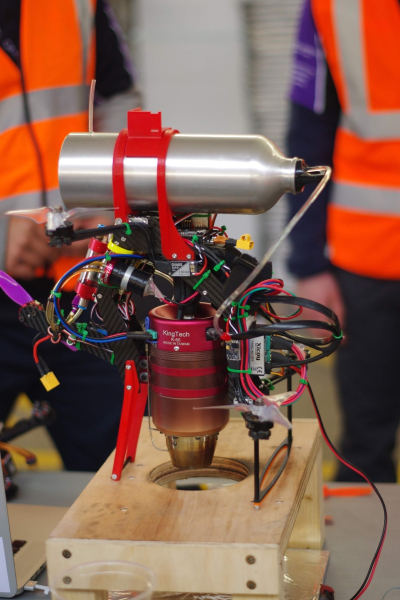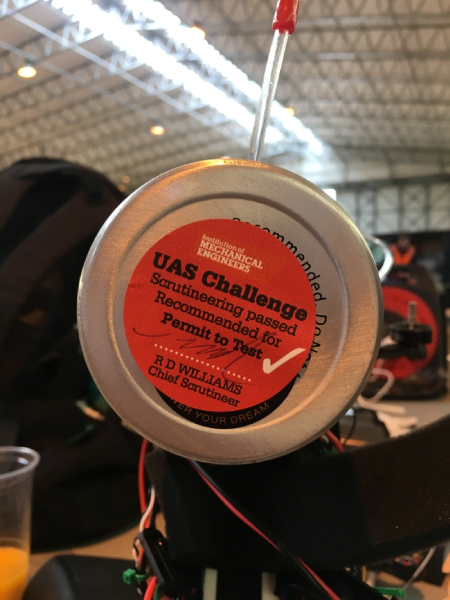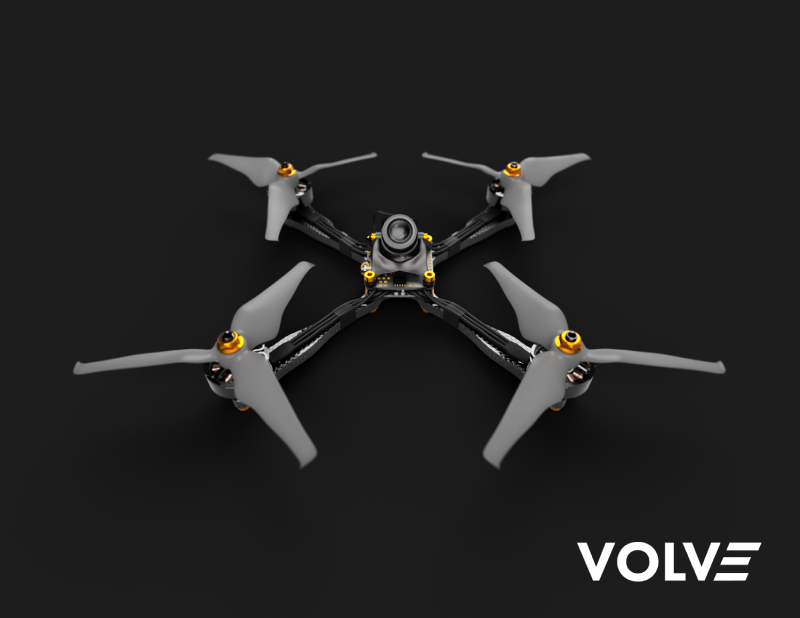Read on to hear from Volve's CEO Arkadiy Serezhkin and CTO Ismail Ahmad and how they experiences in the competition helped support and develop their engineering skills and how this led to the creation of Volve.
Q: Please tell us a bit more about yourself and your background.
Arkadiy Serezhkin (AS): We are both Mechanical Engineering Graduates from University College London. Throughout our degree’s we have always been fascinated in how technology is going to evolve and play an increasingly important role in the future of engineering. For example, my projects have mainly focussed around 3D printing and waste management where I utilized machine learning to detect and identify different types of waste for automated sorting. I was also exploring the entrepreneurial pathway while leading London New Tech which is a community of tech entrepreneurs with more than 16,000 members and participating in UCL Entrepreneurs Society.
Ismail Ahmad (IA): My background is in algorithm design and drone systems and I am currently completing a PhD in Autonomous Systems and Human Machine Interaction. My projects through university were focused around applying algorithmic techniques to develop complex systems. I have worked on developing drone systems to spray concrete to automate the current manual ‘shotcrete’ process, gearbox/electric motor optimisation algorithms and more recently on the UCL-Ventura team that designed and manufactured 10,000 breathing aids for the NHS alongside Mercedes F1 High Performance Powertrains.

We originally met two years ago when we were both on UCL’s UAS Challenge Team (Nova), where we realised we both had similar interests and ideas as to what the future of engineering would look like. Since then we have been working on the team together, where we have always tried to think of and realise radically different drone concepts through new computational engineering techniques.
Four months ago we took those foundations to start a deeptech startup (Volve) focussing on applying artificial intelligence techniques to improve and speed up the engineering process.
Q: Tell us about your involvement in the UAS Challenge.
AS: We participated in both the 2018 and 2019 UAS Challenges. Right from the beginning we took a user centred approach by actually speaking to on ground responders that have worked in these situations. The response was that the system had to be as compact as possible and should not be electricity based. This was due to the electricity supply in disaster regions usually being the first resource to be disrupted. We found that by instead using a micro jet engine we could actually run the system on just about any heavy fuel. This meant in an actual disaster situation you could use diesel from abandoned trucks/cars or even syphon fuel from full scale aircraft entering and leaving the area. Also due to the excellent thrust to weight ratios of micro jet engines we could also develop a very compact system.
Once these constraints were determined we developed an algorithmic approach to determining the best performing configuration for maximizing a combination of key performance metrics including range and stability. This algorithmic approach allowed us to go through thousands of design ideas and assess their performance right at the conception stage, without the usual requirements of designing, simulating and testing the concept. Meaning we arrived at a good solution to the problem very quickly and with a small team of only three members.

The final concept was essentially a tiered quadcopter, with a centralised micro jet engine. Here the jet engine provides the main thrust and the quadcopter system driven off a small alternator is just there to stabilise the system. What we had come up with, through this new design approach to our knowledge was the world’s first jet powered quadcopter.
Unfortunately we did not reach the stability required for performing a mission flight at the 2018 competition, nevertheless we did just start the engine for a test run and came home with the most promise award. However, after coming home from the competition we began to look into the data to figure out why we were not achieving the stability our computer models had predicted and eventually found the bug within the software and had our first successful flight a month after the competition.
Q: What are the top three things that you learned during the UAS Challenge?
AS: When I joined Team Nova, I was in my first year of university and I had never built anything as complex as a drone before. Ismail, who was a team leader on the other hand built his first drone at 9 years old and had outstanding attention towards the level of quality and safety. Participating in UAS taught me three fundamental things: working on innovative and crazy ideas is always better than taking on certain but common projects, the quality of the product needs to be outstanding and discipline is the driver of success.
IA: To plan for the unexpected: engineering is never a linear process and to try and force it into that path or to not account for things going wrong will always lead to a delayed project.
The importance of rigorous data management and version control. This is something we initially took lightly, but even with a relatively small project like this we came to realise how quickly this can get out of hand. Since then we have been extremely detail orientated towards perhaps this ‘softer’ side of engineering, implementing tools like Mashoom for part numbering, version control and Bill of Materials that include all the nuts, bolts and even adhesives.
The need to take an overarching systems approach and not a single part wise approach. All too often we are guilty of becoming narrowly focused on a single part of the project, neglecting everything around it. This only leads to a compromised overarching system/product. We must at times zoom out and take into account how what we are doing fits into the bigger picture.
Q: What’s your favourite memory from being involved in the UAS Challenge?
AS: My favourite memory comes from the day we spent 12 hours assembling and soldering components. We managed to have a flying electronic part of the drone by the end of the day. It was the first time I spent so much time working on the project without almost any breaks and the feeling of accomplishment was overwhelming.
IA: Although we had a huge amount of fun at the competition, perhaps my favourite memory comes just slightly after the competition of when we first got the jet drone flying. As an engineer it is these moments you live for, seeing something you have worked so hard on actually come to life. This project in particular was something very special to me as although the analysis in theory said it should fly, we were never entirely sure whether we could achieve the feat. And having a jet engine hovering a few meters in front of you is something you definitely do not forget in a hurry.
Q: What advice would you give to teams competing this year or students thinking of getting involved?
To do well at the competition is all about testing, testing and more testing. If you examine the results for who has won in previous years, there is a resounding correlation between competition performance and number of flights done before the competition. So build the aircraft early and get flying it, only then can you correct all the issues and bugs before the actual competition flight.

Q: Can you tell us about Volve and how you came up with this idea?
AS: We found it very challenging to quantitatively choose one drone concept over another. For example, is it best to build a fixed-wing, VTOL or Quadcopter? At this early conception stage you know very little about how each configuration affects performance, but the configuration you select is one of the most important contributors to success. Therefore, we are working on an overarching system optimiser that allows the user to quantitatively understand the advantages of one configuration over another depending on the input mission constraints such as payload, required range or flight time.
In the process of doing so the system also determines the optimal battery configuration, motor/prop selection and flight speed to name a few. Having an understanding of how each one of these parameters affect each other and what combination of each is required to maximise performance means development effort and time required to reach performance targets is rapidly reduced.
Currently we have applied this algorithmic approach to drones and are developing and validating the software in this arena. However, we are looking to scale this approach to many different industries and engineering workflows. This we believe will be the future of engineering, where computers are doing the heavy lifting on calculating how design changes are affecting overall system performance empowering engineers with the ability to get answers to their hardest questions. Questions that they have never had answers to before.
We also believe that we are on the verge of the customisation era powered by the 3D printing revolution where we are moving away from mass repetitive manufacture to robotically operated microfactories. Our system would allow an end consumer to have a direct input into the final design. Imagine ordering a car and not just being able to change the colour of the car, but the entire configuration; how many seats? Number of cupholders? Whether ride comfort or performance is more important? All of these would be taken into as constraints to the system and it would produce a custom solution exactly to the customers needs and have it all ready and manufactured for you within a matter of days.
This is where we see Volve fitting into the new age of engineering, driving incredibly complex design decisions and giving that power to consumers and engineers alike to create new, radically disruptive and innovative products.
Q: Tell us more about your collaboration with Autodesk.
AS: We are huge fans of Autodesk softwares and utilise Fusion 360 (Autodesk CAD/CAE package) for most of our projects. Within it is a new part optimisation approach called generative design. We have currently connected the Volve engine and Fusion 360’s Generative Design suite to design the world's first drone developed end to end by an AI, from component selection to the actual frame geometry itself. Currently the first frames have been manufactured and will be used to assess the performance against a human designed counterpart. If the AI is successful in having designed a drone that is equivalent or better than one designed by a human, we believe this will be a huge milestone for the world of engineering.

Q: How can we follow Volve’s Progress?
AS: You can follow our LinkedIn page where we share the most recent news and accomplishments. You can also check for more designs on our website.
We are very keen to speak with engineers and leaders in the UAS space so if you are interested to learn more about our upcoming projects you can send Arkadiy an introduction at arkadiy@volve.ai or connect with me or Ismail on LinkedIn.